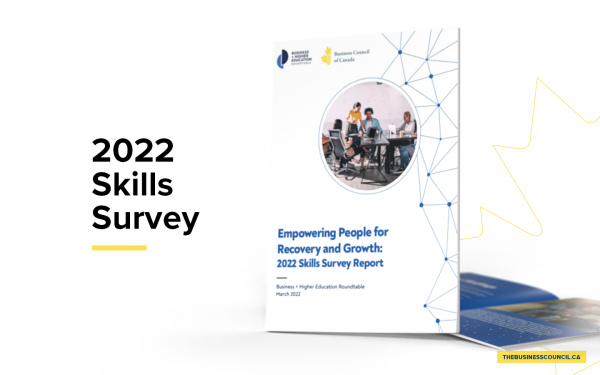Skills development in Canada: so much noise, so little action
Introduction
Here is a dispiriting story for any Canadian worried about finding a job, and any business worried about finding skilled workers.
In 2008, Canada’s labour ministers – federal, provincial and territorial – appointed a blue-ribbon panel to come up with ideas to improve the way their departments collect and share data on the country’s workforce.
No one doubted the importance of the panel’s mandate. Policymakers, businesses,workers, educational institutions and students, among others, rely on accurate and relevant information to ensure that labour markets function smoothly. By helping to match people efficiently with jobs, reliable information is an invaluable – many would say essential – tool to boost productivity and overall economic growth.
As the panel itself observed: “Labour market information can be made a shining example of how Canadian governments can work together to make the Canadian economic union function better to the benefit of all Canadians.”
After more than a year’s work, the five-member group, headed by former TorontoDominion Bank chief economist Don Drummond, submitted 47 recommendations. In compiling its report, the panel was at pains not to inflame federal-provincial jealousies. It estimated the cost of implementing its proposals at little more than $10 million a year, split among the governments.
Four years later, the report is essentially gathering dust. Only two of its 47 proposals have been fully implemented. One is a new job-vacancy survey compiled by Statistics Canada. The other is free access to Statscan’s online database.
As for the rest, Mr. Drummond notes: “We seem no closer to this reality being seized today than we were four years ago.”
The meagre fruits from the Drummond report are emblematic of the obstacles that dog labour market reform in Canada, and thus hamper progress toward an effective national system of skills development.
While many complain about the mismatch between jobs and skills, few have so far been willing to take meaningful action. With a handful of exceptions, all the main players – in business, government and academia – appear reluctant to accept the risks that come with striking out in a bold new direction. Knee-jerk responses to avoid political controversy have invariably trumped thoughtful long-term planning. Little progress has been made in crafting the national (or even provincial) skills development strategy that almost all agree is an essential first step. Inertia has become the order of the day.
The inaction on the Drummond report highlights another disturbing dimension of the skills debate. There is little point bemoaning a shortage of engineers and pipe-fitters in Alberta or a surplus of teachers in Nova Scotia without addressing the root causes of the problem. As Harvey Weingarten, president of the Higher Education Quality Council of Ontario, puts it: “Blustering about a ‘skills gap’ is neither a sophisticated question nor one that leads readily to an answer.”
The reality is that mismatches between skills and jobs, where they occur, are symptoms of complex and contentious issues involving, among others, Canada’s education system, business attitudes towards employee training, federal-provincial relations and even the culture of work. Canadians’ prolonged failure to come to grips with the causes of the problem means that frustration has become the order of the day among all concerned.
Rick Miner, a consultant and former president of Seneca College in Toronto who was also a member of the Drummond panel, says: “Relative to what others do, we’re an embarrassment.” Mr. Weingarten adds: “Every country I know that’s trying to advance and remain competitive and advance the lot of their people concentrates on education and higher education in particular. How is it that we cannot address this problem in the most coherent, effective way possible?”
The depth of the business community’s unhappiness was reflected by Michael Denham, President and Senior Managing Director of Accenture Canada, in a recent speech: “This is a real and serious issue that has the potential to undermine the strength of individual companies – and the broader prosperity of Canada itself.”
Abigail Fulton, Vice-President of the British Columbia Construction Association, voices the exasperation common to business managers who confront the skills problem every day: “There are so many roundtables and debates about the shortages, it’s like, oh my God, I’m done talking about it. Let’s do something about it, instead of just whining about the shortages.”
Government clearly also senses the enormity of the challenge. On the day he was sworn in as Minister of Employment and Social Development in July, Jason Kenney posted on Twitter: “I will work hard to end the paradox of too many people without jobs in an economy that has too many jobs without people.”
Examples of such mismatches are not difficult to find. Too many bright, ambitious youngsters with university degrees are working behind cash registers, as administrative assistants or as unpaid interns. Nova Scotia and Ontario, among others, are struggling to find jobs for droves of unemployed or underemployed primary- and secondary-school teachers. At the same time, businesses complain about insufficient numbers of engineers in Alberta, construction workers in British Columbia and computer experts throughout the country. Women make up only 10 per cent of Canada’s computer science students, many disabled people are working well below their potential, and too many skilled immigrants can find jobs only in low-wage settings such as fast-food outlets or as taxi drivers.
Some of these imbalances are likely to worsen in the years ahead as a result of demographic trends – in particular, the gradual aging of the country’s labour force. According to Statistics Canada and the Conference Board of Canada, the average age of Canadian workers rose from 38.3 years in 1996 to 40.2 in 2006. Yet the influx of young people into many critical occupations has slowed under a combination of corporate cost containment, restrictive union rules and poor planning by universities and colleges, among other factors.
An example that touches many industries is the shortage of truck drivers. The average age of a trucker climbed from 40 years in 1996 to over 44 a decade later, and is almost certainly higher now. Only 12 percent of Canadian truck drivers are under 30 years old. Many companies already struggle to find drivers, and the shortage is worsening as baby-boomers retire and the economy grows. The same problem is rearing its head in the skilled trades. The pool of journeymen available to train young apprentices is shrinking as experienced plumbers, millwrights, welders and other badly-needed artisans reach retirement age and drop out of the workforce.
On the other side of the equation, demand for highly skilled workers is rising – not just in absolute numbers but also as a proportion of the overall workforce.
Canada has been slow to come to grips with the fact that even existing occupations require ever-higher degrees of skill. Jobs that once were open to anyone with a secondary school diploma now demand an apprenticeship, a degree or a professional accreditation. For instance, the job of an auto mechanic has changed dramatically as cars have evolved to include increasingly sophisticated electronic equipment. Indeed, the person once called a “mechanic” is now more often described as a “technician”.
Many other jobs once considered relatively straightforward – from elevator repairman to telephone technician – are in the throes of a similar journey up the skills ladder. This phenomenon is not confined to occupations with a technical bent; consider the fact that the Ontario government is currently considering a set of minimum qualifications for condominium managers, an occupation that up to now has had low barriers to entry.
The Deputy Minister of Employment and Social Development Canada (formerly Human Resources and Skills Development Canada) has estimated that three-quarters of new and replacement jobs will require at least some post-secondary education or equivalent training. British Columbia’s Ministry of Advanced Education and Labour Market Development has put the number even higher, at 80 per cent.
Mr. Miner estimates that without dramatic changes in skills development policies, almost 550,000 Canadian workers will not have the skills needed to fill available jobs in 2016, growing to 1.1 million in 2021. (These figures are in addition to normal unemployment.) At the same time, he says, almost 1.5 million skilled jobs will be unfilled in 2016 due to shortages of trained workers, rising to 2.6 million in 2021 and almost double that number a decade later.
Canada’s Solid Foundations
In some ways, Canada is well-equipped to meet the challenges of a more demanding global economy. Our education system has traditionally been ranked among the world’s best, and our workforce among the most highly qualified. According to the Organisation for Economic Cooperation and Development (OECD), Canada – along with Japan, South Korea and Russia – has the highest proportion of people ages 25 to 34 with a university or community college education. Canada is one of only five countries where more than 20 per cent of students graduate from short, vocation-oriented programs; across the 34 countries of the OECD, the average is just 10 per cent. What is more, our overwhelmingly public system means that the quality of schools across Canada is far more consistent than in the United States, putting many more young people in a position to acquire the skills needed for more than a minimum-wage job.
Few, if any, countries are as successful as Canada in attracting foreign students and skilled immigrants. Canada attracts about five per cent of all foreign students worldwide, more than double the proportionate size of our economy. According to the OECD, more than 45 per cent of immigrants to Canada have a tertiary (university or college) education, compared to less than 40 per cent in the United States, United Kingdom and Australia. Almost a third of them are enrolled in courses related to science, engineering or agriculture. The federal government has opened up a fresh pool of talent to employers by relaxing immigration rules so that foreign students can stay on after graduation.
Much of the superstructure for efficient skills development is also firmly in place in the form of well-run and well-equipped schools, universities and colleges. Some Canadian educational institutions already win wide praise for their efforts to collaborate more closely with business and government so that graduates are equipped with the skills that employers want. High on most lists are Calgary’s Southern Alberta Institute of Technology, also known as SAIT Polytechnic, and its counterpart in Edmonton, the Northern Alberta Institute of Technology (NAIT).
At SAIT, 65 advisory committees made up of 1,000 business and industry experts provide recommendations on degree and apprenticeship programs and curriculums. To cite one example: SAIT joined forces with six big energy producers last year to launch a certificate program for specialized water-treatment operators for oil sands projects. The curriculum, comprising three 15-week semesters, is the first of its kind in North America. A full contingent of 34 students enrolled in the first class in September 2012, roughly in line with industry estimates that about 35 additional operators will be needed each year over the next decade. Similarly, NAIT in Edmonton claims that 87 percent of its millwork and carpentry students find jobs within a year of graduation.
Saskatchewan’s Northern Labour Market Committee is another pioneering – though little-noticed – example of collaborative skills development. The committee brings together representatives of government, employers, educational institutions (from kindergarten to post-secondary), economic development agencies and aboriginal communities in one of Canada’s most impoverished and remote regions. The group has sought to bridge the gap between fast-growing need for skilled labour, especially in the mining industry, and the insufficient supply of local skills. To that end, mining companies share details of their human-resource needs, plans and problems, paving the way for sector-wide training programs. All partners contribute to training commitments and funding for scholarships, apprenticeships and other training programs. The committee can point to some tangible progress. Northern residents now make up half of the workforce at mine sites in the region, up from less than a third in 1986. The proportion of these workers in skilled jobs has also risen markedly.
Business groups have come up with a variety of creative ideas to address present and looming skills shortages. Equally important, some have shown dogged determination to overcome obstacles in their way. British Columbia’s construction industry has recognized that young people are more likely to be drawn to the trades if they have the opportunity in high school to work with cutting-edge tools and equipment. To that end, the industry’s philanthropic foundation is planning to raise funds to modernize shop facilities at schools throughout the province. On another front, the Certified General Accountants Association of Canada launched three challenges under the interprovincial Agreement on Internal Trade to ensure that members qualified in one province would have the right to practice in other parts of the country. “The issue today is resolved,” says Carole Presseault, the association’s Vice-President, Government and Regulatory Affairs.
The not-so-good news
Initiatives such as these carry an important message: it can be done. But regrettably, they are the exception rather than the rule. While Canada still consistently ranks near the top – in some cases, at the top – of countries where people would most like to live and work. its standing is jeopardized by deteriorating scores on some of the key measures that influence these rankings. Canada has fallen from ninth in 2009-10 to 14th in 2013-14 in the World Economic Forum’s global competitiveness rankings. It has dropped from ninth to 16th in the share of the population enrolled in higher education and training. Among the “most problematic factors” for doing business in Canada cited in the latest WEF report are insufficient capacity to innovate (ranked in third place), restrictive labour regulations (sixth), and an inadequately educated workforce (eighth).
The depth of Canada’s malaise is evident from the OECD’s first Skills Outlook report, published in October 2013. According to the report, which evaluates adult skills in 24 countries, Canada’s literacy score has dropped seven points in the past decade, based on comparable historical data. Canadian adults’ literacy score is only about average and our numeracy proficiency is below average. Especially sobering is that young Canadian adults (ages 16 to 24) score “significantly below” the OECD average in literacy, and display weaker math and literacy skills than the next youngest group of Canadians (ages 25 to 34). The survey also highlights Canada’s mediocre performance in adult education.
Canada’s ranking would be even worse were it not for the stand-out performance of Alberta and, to a lesser extent, Ontario and British Columbia. Quebec, Saskatchewan and the Atlantic provinces rank below average on most measures. (Regrettably, the Council of Ministers of Education chose to react to the OECD report by trumpeting Canadians’ slight lead on computer prowess, while ignoring the more disturbing big picture.)
Meanwhile, the International Labour Organization reports that Canada had only 30 apprentices per 1,000 employees in 2011, well below Germany with 39, Australia with 40 and Switzerland with 44. According to the OECD, more than 70 per cent of uppersecondary students in some European countries – Austria, Belgium and Finland, for example – take part in some kind of vocational program. Canada, in contrast, is one of just six countries where more than three-quarters of upper-secondary students are enrolled in general programs rather than vocational education and training.
The Canadian Chamber of Commerce found a sombre mood among its members in an extensive survey of skills issues in mid-2012. The chamber heard, in its words, a “dismaying story of a workforce which often lacks basic skills – literacy, numeracy, communications skills – to compete in the modern workplace. Canada urgently needs policies, programs and attitudes to support continuous life-long learning and skills upgrading.”
In her recently published and widely acclaimed book, The Smartest Kids in the World and How They Got That Way, U.S. investigative journalist Amanda Ripley comes to some telling conclusions on why other countries – including some unlikely ones – are pulling ahead of the United States. Many of her insights are equally relevant to Canada.
Ms. Ripley followed three U.S. foreign-exchange students for a year – one each in Finland, Poland and South Korea. One common thread in their experiences, she concludes, is that teachers in those three countries have remarkable authority, status and commitment to excellence. Thus, Ms. Ripley has little sympathy for what she describes as the “perverse sort of compassion” that discourages North American teachers from failing poorly performing students.
“High school in Finland, Korea and Poland had a purpose, just like high-school football practice in America,” she writes. “There was a big, important contest at the end, and the score counted. Their teachers were more serious, too: highly educated, welltrained, and carefully chosen. They had enough autonomy to do serious work; that meant they had a better chance of adapting and changing along with their students and the economy. The students had independence too, which made school more bearable and cultivated more driven, self-sufficient high school graduates. The closer they got to adulthood, the more they got to act like adults. In the U.S. and other countries, we’ve put off this reckoning, convinced that our kids would always get second and third chances well into adulthood. We’ve had the same attitude toward teachers: Anyone and everyone could become a teacher, as long as they showed up for class, followed the rules, and had good intentions.”
Among the three countries that Ms. Ripley surveys, Poland has reaped the benefits of sweeping reforms spearheaded by an assertive minister of education, starting in the late 1990s. The improvements included a new curriculum, standardized tests and raising to 16 from 15 the age at which students are separated into academic and vocational streams. Ms. Ripley describes South Korea as a “booming education bazaar” that can teach many other countries “how to motivate teachers, how to captivate parents and students, and how to adapt to a changing world.” Though Finland has virtually no private schools, children there enjoy an abundance of schooling choices, including specialized international, science, music and foreign language schools. About half of Finnish teenagers choose job-training or vocational high schools. The government, Ms. Ripley reports, “recently lavished vocational schools with funding and performance bonuses, so regular academic high schools had to work even harder to keep their students.”
These policies have produced impressive results. Finland has risen to third place in the WEF competitiveness index (compared with Canada’s 14th), from seventh two years ago – and its higher education and training system is judged number one among 144 countries. Most South Koreans were illiterate as recently as the mid-20th century. Today, Korean 15-year-olds rank near the top in the world in reading, and the country boasts a 93 per cent secondary school graduation rate, compared with 83 per cent in Ontario. In contrast to Ontario’s sliding performance, Korea’s overall competitiveness ranking has climbed from 22nd to 19th in the past two years.
Where has Canada Gone Astray?
It is fair to say that Canada’s geography and constitutional division of powers are less than conducive to shaping an effective national skills policy. Thousands of kilometres often separate desperate employers from desperate work-seekers. A recent survey by the Canadian Council of Chief Executives suggests that Canadians may be less mobile than Americans when it comes to looking for work. Many of the respondents pointed to “a reluctance of some Canadians to relocate in search of work” as an important reason for skilled labour shortages.
Labour mobility might be less of an issue if more formal channels existed for employers and job-hunters to telegraph their needs to one another. Governments, businesses and educational institutions exchange far too little information on demand and supply for labour. Collaboration on how to move from a problem to a solution is all too rare. As Ken Coates, Canada Research Chair in regional innovation at the University of Saskatchewan, puts it, “The current system provides only “loose and weak signaling, from time to time.”
One indisputable handicap is that Canada is the world’s only developed country without a national education ministry or a national education strategy. The federal government has all but bowed out of any meaningful role in education policy. Its initiatives since the mid-1990s have been confined to tax concessions and student aid improvements – designed, critics say, more for political optics than for an impact on the labour market.
Yet the barriers created by geography and jurisdictional issues are not necessarily insurmountable. Labour and education specialists gaze with envy at their counterparts in the healthcare field who have overcome their differences to create a national system of healthcare information. The Canadian Institute for Health Information (CIHI), a government-funded national agency, has assembled a trove of data covering all provinces and territories on such critical variables as availability and quality of care, wait times and outcomes. The information collected by CIHI has become an invaluable tool in shaping healthcare policy across the country, and driving players in the sector towards improved performance.
How can it be that such cooperation is possible in healthcare, but not in education or labour? Each of the main players has much to answer for.
Governments at both the federal and provincial level have failed to show initiative and leadership. The Council of Ministers of Education Canada (CMEC), set up by the provinces and territories, claims to provide “national leadership” in education. But the body, which employs more than 60 people, has little to show so far for 45 years of effort.
Politicians have all too often failed to take the long view. They have responded, for example, at lightning speed to complaints – no matter how ill-informed – that temporary foreign workers are taking the jobs of qualified Canadians. Yet, as the record of CMEC and its equivalent in the labour field, the Forum of Labour Ministers, shows, they have demonstrated little appetite for initiatives that could make important contributions to long-term skills development, such as standardized national testing and more transparent data on educational achievement.
Boldness and creativity are equally lacking in the education system. Compare Canada’s record with that of New York City, a fractious place if there ever was one. The Financial Times newspaper noted recently that, “under Mayor Michael Bloomberg, New York has become a laboratory of educational experiment. In efforts to improve the city’s schools, which vary wildly in quality, he has encouraged entrepreneurs and innovators to apply their ideas to education. . . . Investments by companies such as Google and Facebook have made New York a magnet for computer scientists and designers.”
Yet in Canada, educators at all levels tend to resist change rather than embrace it. Canadian teachers and administrators have long been reluctant to subject their performance to scrutiny, apparently fearing the consequences of accountability. And governments have shown an equal reluctance to intervene, especially at the university level.
Too many university professors and administrators still cling to the notion that success is defined by ivory-tower research and that any university worthy of the name must offer an array of post-graduate programs, even when those programs are of questionable practical value. Andy Chan, who heads a groundbreaking Office of Personal and Career Development at Wake Forest University in North Carolina, told The New York Times recently that, “If universities want to preserve the liberal arts, they have a responsibility to help those humanities majors know how to translate their studies into the work world.” Yet how often do we hear of Canadian universities shutting down a program because its graduates have had little success finding a job?
Turning to the business world, trade unions have all too often focused on protecting their own turf and boosting their members’ earnings, without taking into account the future health of the companies that employ them and the needs of the economy as a whole. This myopia sometimes comes at the expense of the unions’ own long-term interests. Thus, some unions have resisted stepped-up immigration of skilled workers, even though those newcomers could eventually yield a valuable pool of new union members.
Employers, who have most to lose from inefficient allocations of labour, also have much to answer for. The biggest employers – including large financial institutions, energy and transport companies – tend to have highly developed workforce training systems. But many other Canadian businesses have shown less interest in helping employees to upgrade their skills; a commonly voiced concern is that workers, once trained, will move on to another employer. Collaboration with universities, colleges and governments to set long-term policies and shape curriculums is rare. Training budgets are modest and are typically among the first items to be cut when belts are tightened. As Alex Usher, president of Higher Education Strategy Associates, a Toronto-based consultancy, puts it, “The basic view is that training is a cost, not an investment.”
Labour Market Information
One of the most glaring examples of Canada’s failure to come to grips with the root causes of inadequate skills development is the dearth of information needed to guide an efficient labour market.
Labour market information, known as LMI, may sound like a dry, theoretical subject. However, as the 2009 Drummond report noted, “Like all markets, labour markets run on information. And to function really well, they absolutely must have accurate and timely information. Labour markets transform the individual decisions about labour supply and demand into price signals that allocate labour and determine income. And the better the information that all the participants have in making their decisions, the better they work.”
Angel Gurria, the OECD’s secretary-general, observed in a foreword to the body’s annual Education at a Glance publication: “The size of the investment in education is now too big, and its benefits too central to the success of economies and societies, for the design of effective education systems to take place in the dark. With economic competition now global, countries can no longer afford to measure their education systems against national standards.”
Yet Canada has not even reached the stage of national standards. Echoing many others, Mr. Usher says that “Statistics Canada is in the 19th century. They’re not good at the basic stuff that everybody should be good at, let alone the more advanced stuff that we really need.”
The extent of the problem is evident in publications that compare Canada’s education performance to that of other countries. Information on Canada is missing from many of the tables in the OECD’s Education at a Glance report, which is widely regarded as one of the most authoritative sources of international education data. Canada was the only one of 34 jurisdictions that was unable to submit data for a 2012 study by the OECD’s Program for International Student Assessment (PISA) on the crucial question of whether performance-based pay improves teaching standards in schools. In the words of the Drummond report, “we were struck by the fact that even relatively straightforward educational data on colleges and degree-granting institutions, as well as data on workplace skills use, are unavailable or years out of date. . . . This result is starkly at odds with the aspirations of a knowledge-based economy and society.”
Statscan last published its supposedly annual Workplace and Employee Survey in 2009, covering the period 1999-2006. The agency began publishing a job vacancy survey last year, but the results have limited value. For example, the survey may reveal that there are vacant engineering jobs in Ontario, but says nothing about the types of engineering jobs or whether the vacancies are in Toronto, Sudbury or Windsor. The National Household Survey provides data on the “highest” certificate, diploma or degree earned by Canadians. But the survey confuses rather than informs by encouraging respondents to think of their qualifications in terms of a hierarchy. About 15 per cent of students in colleges and polytechnics already have a university degree. The wording of Statscan’s questionnaire encourages those respondents to identify the university degree as their highest qualification – even though, in many cases, it was the college diploma that landed them a job. The survey thus inflates the usefulness of a degree while playing down the value of a college qualification.
The Canadian Occupational Projection System (COPS), which projects future labour market conditions on an industrial and occupational basis, is also flawed. In the late 1990s the system predicted that there would hardly ever be another job created in the oil patch. In the early 2000s, just as the dot-com bubble was bursting, it forecast a continuing surge in IT jobs, including those at fairly low skill levels. Mr. Drummond notes that “with the proper attention it has lacked for much of its history, COPS could be an important cornerstone of a labour market strategy.”
Some sectors have overcome the LMI challenge by taking matters into their own hands. The main players in the construction industry came together in April 2013 to form BuildForce Canada, with a mandate to provide accurate and timely employment data for employers and workers. Its reports cover demand and supply for 33 different trades and occupations. BuildForce’s board of directors is drawn from contractors, labour groups and client companies. Rosemary Sparks, the group’s executive director, dismisses any role for Statistics Canada in collecting this data. “Labour market information is most valuable when it’s at the sectoral level,” she says. “Unless you understand how the industry operates, you can’t provide the type of information and you can’t do the analysis of the data appropriately.”
Hidebound Traditions
Like it or not, some deeply entrenched education and workplace practices in Canada are increasingly at odds with progressive skills development.
The basic structure of most high school and post-secondary programs harkens back to a bygone era when most students worked on the family farm and could fit in their studies only between the fall harvest and summer planting. More recently, the three-tofour month summer vacation for post-secondary students has been justified by their need to work to pay for their education. But, as Mr. Miner notes, “What we need to realize is that this arrangement also carries a substantial social cost, a cost that will only increase.” If university students spent just two of the four summers of their programs in school, they could complete their studies and look for jobs a year earlier.
Canada’s apprenticeship system has similar shortcomings. It takes roughly one-third longer to qualify as a carpenter or welder in Canada than in Germany. Furthermore, many European countries’ apprenticeship programs combine daily classroom and workplace learning. By contrast, Canada uses a “block” system in which each activity stretches over several weeks or months. With theoretical and practical components so disconnected, apprentices have greater difficulty applying what they have learned, undermining the quality of the program. The oft-cited benefit – that businesses can use employment insurance as a subsidy to fund part of their apprentices’ training – is a classic example of short-term expediency, with tradition trumping the pursuit of longterm excellence.
Thankfully, one tradition has started to dissipate: the long-standing bias among Canadian students and parents toward a university education rather an apprenticeship or a community-college program. Growing numbers of university graduates, realizing the limitations of their degrees, are returning to school to learn a trade or technical skill. The trend is reflected in rising apprenticeship registrations: up from 281,900 in 2005 to almost 383,000 in 2010 (latest data available), according to Statscan.
Colleges have become finishing schools for a growing number of young adults about to enter the workforce. Using Ontario as an example, Mr. Miner estimates that the number of university graduates who have subsequently enrolled in full-time college courses in the province has ballooned by more than 75 per cent since 2003. This does not include the 14,400 students who enrolled in Ontario colleges after completing some university credits but not a full degree.
Even so, resistance to so-called “blue-collar” work remains much stronger in Canada than in many other countries, especially in Europe. Although a degree is demonstrably a less valuable commodity than it used to be, many parents still see a university education as a more attractive option for a bright, ambitious son or daughter than a trade or technical qualification. But the evidence increasingly contradicts that view. The aspirant oil sands water-treatment operators now studying at SAIT Polytechnic can expect starting salaries of $85,000 to $125,000 a year. By contrast, TVOntario’s flagship public affairs program The Agenda devoted a full hour in September 2013 to a roundtable discussion titled, “What can you do with a BA?”
Teaching More Useful Skills
The current public discourse on skills development centres on the assumption that the supply of highly qualified people can somehow be quickly turned on and off to meet fluctuating demand for specific occupations, whether chemical engineers, family doctors or computer scientists.
This premise may have some validity for jobs with clearly defined skills set by a regulatory agency or professional body, which oversees training standards and has a good overview of current and future demand. Lawyers, doctors and actuaries are among those that come to mind. But it is also simplistic and of little relevance to the modern workplace or career path.
Even the most finely tuned education system, the most collaborative employers and the most efficient labour market will never entirely eliminate mismatches between workers and jobs, especially in a country the size of Canada. Designing a new program and turning out new graduates takes time, typically as long as six or seven years. Business conditions can change dramatically during that transition period, transforming a shortage of skills into a surplus, and vice versa. Just a year ago, bricklayers were in abundant supply in British Columbia. But a big project to modernize Rio Tinto’s aluminum smelter at Kitimat has suddenly created a shortage. “The challenge for the construction industry is that it’s cyclical,” says Ms. Fulton of the B.C. construction association. In a comment that also applies to many other sectors, she adds: “You can get a shortage one month and a glut the next, depending who is bidding on what project.”
A drive to match specific skills to specific occupations ignores another obvious fact: we have little idea in 2013 what skills will be needed when today’s students enter the labour market, much less when they are in mid-career a decade or two down the line. The White House’s Council of Economic Advisors has noted that a quarter of occupations in the United States in 2003 were not even listed by the Census Bureau in 1967. Similarly, no one could have foreseen 15 years ago the skills now demanded by such fast-growing companies as Google, Facebook, LinkedIn and the legion of smartphone app developers. Adam Gordon, a U.S. author who describes himself as an “educator in industry foresight,” predicts that society will be clamouring in the not-toodistant future for such now unheard-of occupations as memory augmentation surgeon, old-age wellness manager, waste data handler and weather modification police.
The fast-moving and unpredictable job market is likely to give a growing head-start to job-seekers who have paid less attention to skills tied to a specific occupation than to broad “competencies” applicable to a wide range of jobs and even an entire career. These attributes – also known as employability skills or soft skills – include critical thinking, problem-solving, communication skills, numeracy, teamwork and time management.
One result is that the value of traditional university and college courses is increasingly being questioned. According to a survey conducted earlier this year for the Association of American Colleges and Universities, no fewer than 93 per cent of employers agreed that job candidates’ ability to think critically, communicate clearly and solve complex problems was more important than their undergraduate majors. More than three-quarters of employers said they wanted universities to put more emphasis on developing five key learning outcomes: critical thinking, complex problem-solving, written and oral communication, and applied knowledge in real-world settings.
Sensing which way the wind is blowing, far-sighted educational institutions are looking to improve their students’ chances of finding a job, without taking away the satisfaction of their chosen field of study. A recent article in The New York Times Magazine summed up this dual goal: “No, liberal arts majors aren’t necessarily doomed to lives of poverty. But why not add a minor in entrepreneurship just in case?”
The Wall Street Journal reported in August 2013 that seniors at about 200 U.S. universities will take a test next spring that “aims to cut through grade-point averages and judge students’ real value to employers.” The 90-minute test, known as the Collegiate Learning Assessment (CLA), is administered by the Council for Aid to Education, a New York-based non-profit group. It seeks to assess the attributes most valued by employers, particularly soft skills. Other similar initiatives in the United States include a National Career Readiness Certificate, devised by ACT, a non-profit organization formerly known as American College Testing. The certificate is intended to offer verification of a student’s skills in areas such as understanding and applying information presented graphically.
As The Wall Street Journal noted, the new CLA test “represents the latest threat to the fraying monopoly that traditional four-year colleges have enjoyed in defining what it means to be well educated.”
Complex, contentious issues
Canada clearly has much work to do in the field of skills development. Deep-seated reforms are urgently needed across a wide swath of the labour market and education system. Success will be measured not by some magic formula that matches available people to available jobs, as the issues has hitherto been framed. Instead, all those involved need to come to grips with a range of profound and, yes, contentious questions. Among them:
- What can be done to encourage closer collaboration between businesses and educational institutions, especially colleges and universities?
- Should the private sector play a more active role in Canada’s education system? If so, how?
- How can Canadian education be infused with a spirit of entrepreneurship, innovation and accountability?
- How can school and university teachers’ performance be measured and improved?
- How can students improve their chances of securing a fulfilling and well-paid job after graduation?
- How can we further foster a culture that places as much value on an apprenticeship or technical certificate as on a university education?
- What can be done, whether in the public or private sector, to produce more useful education and labour market data?
- How can businesses be encouraged to provide more long-term training for their employees, including hiring more apprentices?
- Can tax incentives for training be adjusted to make them more effective in balancing supply and demand, without necessarily costing taxpayers more money?
- What can be done to realize the unfulfilled employment potential among groups such as senior citizens, immigrants and disabled people?
The answers to these questions are by no means clear-cut and, regardless of the shape they take, will not be easy to implement. But without progress on at least some of these fronts, Canadian businesses will not find the workers they need, Canadian students will not find the jobs they want, and Canada’s economy will not achieve the growth that its citizens have a right to expect.












